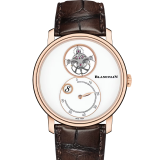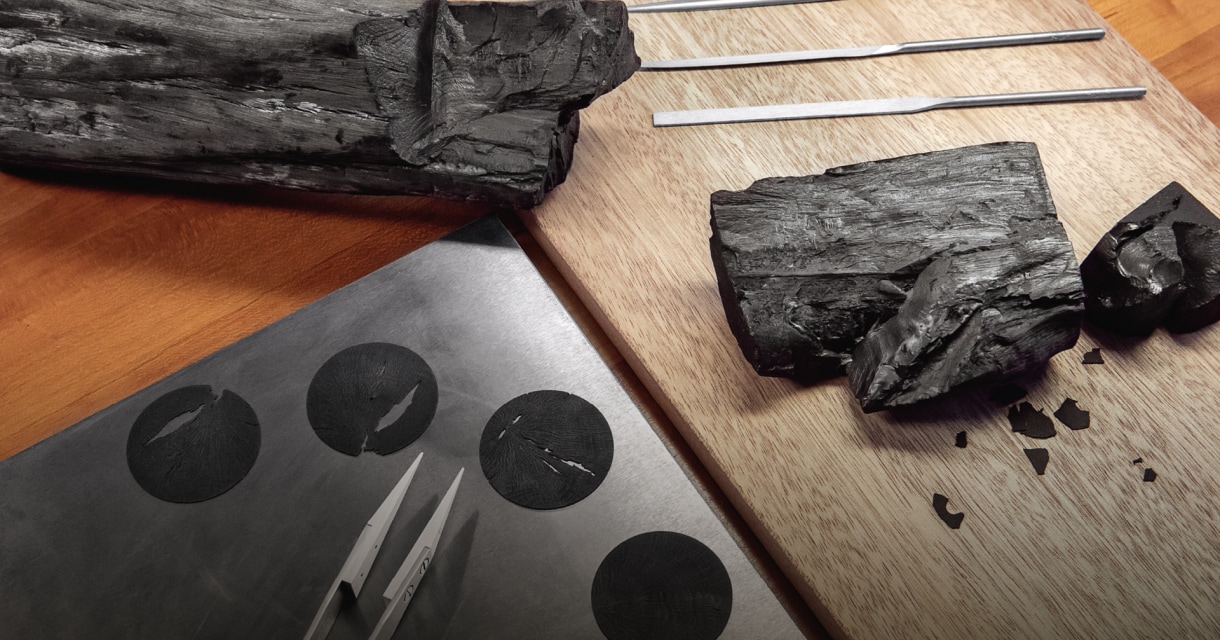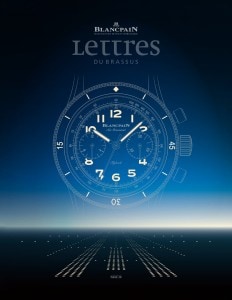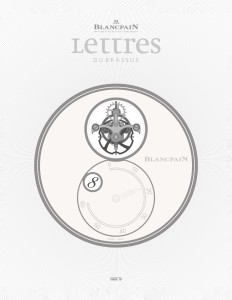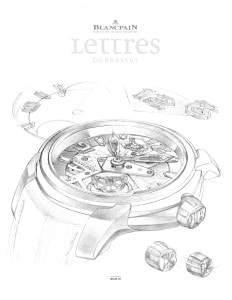
Search in Issues
Chapters
List of parts
Chapter 1
Villeret Tourbillon Volant Heure Sautante Minute Rétrograde
Blancpain’s signature tourbillon expressed in a new way.
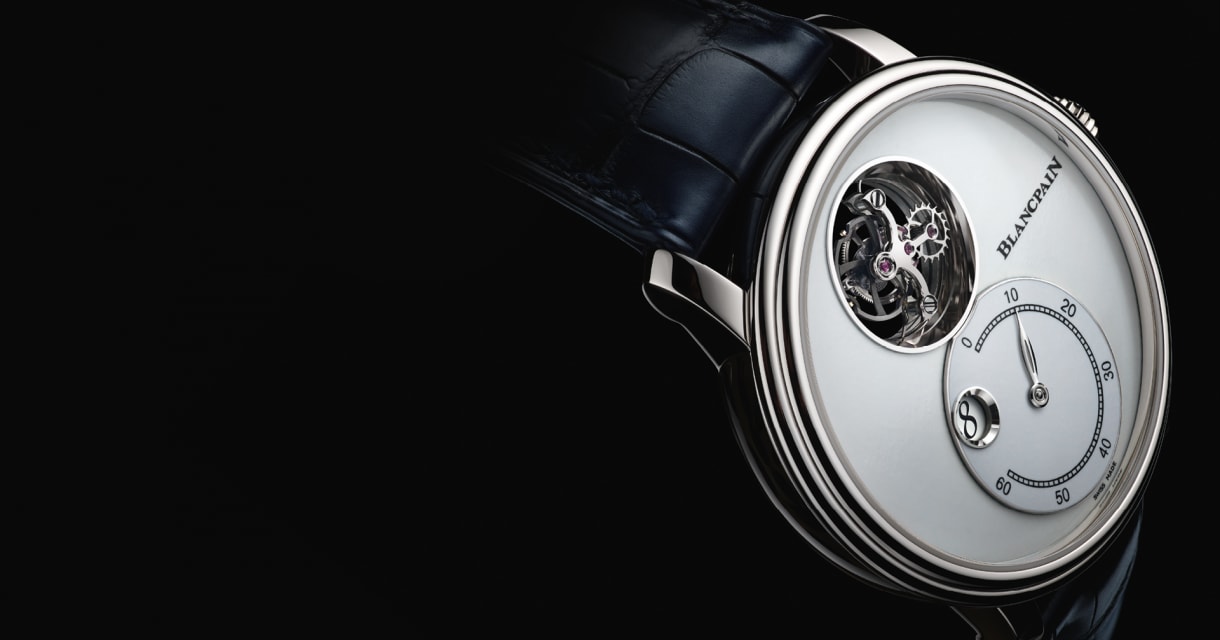

An invisible suspension and power train generates the “WOW Factor” of the new Villeret tourbillon.
When magicians, the world over, with extravagant flourishes wave capes over their object of choice, we have all seen and heard them dial up their theatrical powers into overdrive. Face beaming, eyebrows arched, the dramatic crescendo arrives punctuated with the famous phrase: “now you see it”…(cue the audience gasp)…“now you don’t”. For its newest tourbillon one might imagine Blancpain borrowing and riffing from the same magician’s script “now you don’t see it; and now you still don’t”. This is because this newest version of Blancpain’s signature flying tourbillon visually seems to float in space, rotated and animated by unseen forces. This dramatic presentation is no magician’s illusion. Instead, it is the product of a construction that places the tourbillon upon an invisible transparent bridge with its power delivered by a hidden gear train.
The invisible suspension and power train generates the “wow factor” of the new Villeret Tourbillon Volant Heure Sautante Minute Rétrograde which debuted in 2018 and almost certainly is the first thing noticed with the timepiece in hand, but that innovation is just one of many innovations which distinguish this newest member of the Villeret collection. Above and beyond the tourbillon construction, this new model features three other firsts for Blancpain: the first jumping hour paired with a tourbillon; the first retrograde minute paired with a tourbillon; and the first hand-painted white enamel dial. Whether taken individually or as an ensemble, these elements testify to the ambition of its conception and creation.
Of course, any tour of this timepiece must start with the tourbillon. Since it debuted in 1989, Blancpain’s tourbillon design has been emblematic of the house. It was no less than the world’s first flying tourbillon in a wristwatch. If the word “standard” can ever be used for a complication as demanding as a tourbillon, throughout the horological universe the “standard” way of constructing a tourbillon is to suspend its elements—the carriage, balance wheel, balance spring and escapement—between two bridges, top and bottom. Thus, anchored above and below, these core timekeeping elements rotate in such a way as to cancel out the small rate errors caused by gravity with the watch inclined vertically. Blancpain pioneered a considerably more difficult construction, eliminating the upper bridge and supporting the tourbillon entirely from below. Watchmakers term this design “flying” with nothing spanning across the top or interfering with the view of the tourbillon from the dial side. The carriage, balance wheel, and escapement are all opened up to display their complex theater of motion: the carriage rotating once per minute; the balance wheel oscillating; and the escapement marching around the fixed wheel.

GOING BEYOND the new tourbillon construction is a list of FIRSTS for Blancpain.
Blancpain’s innovative design had one additional key element. Standard approaches followed the original conception of the world’s first tourbillon patented by Abraham-Louis Breguet in 18011. His patent filing placed the balance wheel centered in the rotating carriage. As Blancpain reflected upon what was, in effect, the uniform practice, it saw that de-centering the balance wheel would enable a thinner profile. The result was not only the world’s first flying tourbillon, but the world’s slimmest tourbillon assembly.
This pioneering tourbillon architecture has become a symbol of Blancpain in the three decades since its debut. It is honored in this newest tourbillon as, over this span of time, it has generally defined the construction of all the tourbillons in the collections, with the exception of the 1735 grand complication. That said, Blancpain’s designers conceived two major modifications for the new model to create the illusion of a tourbillon rotating in space. First is the re-imagining of the lower bridge. Since 1989 all of the tourbillons have been constructed with a metal bridge spanning below across the tourbillon porthole. Fitted within this lower bridge is the ceramic bearing assembly supporting the flying tourbillon and placed upon it, as well, is the fixed wheel around which the tourbillon rotates.
The new caliber 260MR eliminates the lower metal bridge. Phrased that way, this description might inspire frissons among connoisseurs. If the flying construction eliminates the top bridge and the new construction eliminates the lower metal bridge, how exactly is the tourbillon supported? What’s the trick? Of course, the tourbillon is well supported from below. The trick is an invisible sapphire support. The bearing assembly and the fixed wheel are both mounted upon the transparent sapphire. This is the first step in achieving the remarkable new appearance.
The second step is equally clever. Since 1989, Blancpain’s classic tourbillons have all been driven via a pinion centered on the carriage. The pinion is engaged with the watch’s power train beneath the lower bridge. The caliber 260MR changes this. Instead of a center pinion, the carriage is fitted with an outer wheel which is hidden behind the dial. Examined closely, one can
see two arms extending outward from the carriage; the connection to the wheel is hidden along with the wheel itself. That wheel, in turn, is engaged with the power train.
The combination of these two ingenious elements, the sapphire mounting and the hidden outer wheel, yield the dramatic presentation of the tourbillon turning in space, energized by unseen connections.
The design process that spanned nearly four full years originally imagined displaying the time via a jump hour in a window and a conventional minute hand. A jumping hour is a complication: the hour is shown with a digit which, as the name suggests, instantly “jumps” to the next hour as the time passes beyond 59 minutes 59 seconds. However, with this combination of jump hour and conventional minutes, Blancpain’s movement designers saw a problem. As the time approached and began to advance past the 59 minute mark, there could be an ambiguity arising from the timing of the jump. Had the hour already jumped or was it about to jump? Was the displayed hour the previous hour or the next hour? After a minute the ambiguity would disappear, as it would be certain that the “jump” had already occurred. Nonetheless for a few seconds every hour there could be uncertainty concerning the correct hour.
In order to resolve that problem, Blancpain decided to pair the jump hour with a retrograde minute display. A retrograde minute display is one where, at the conclusion of the hour, the minute hand would itself instantly reverse its clockwise movement and quickly return from its forward march to zero, or in the parlance of watchmakers “retrograde” to zero. By combining and linking together an instantly retrograding minute hand with the instantly jumping hour, all ambiguity would be removed. Said another way, if the jump of the hour and the retrograding of the minute both occurred at the same instant, all uncertainty would be eliminated. As soon as the minute hand snapped back to zero, it would be certain that the hour had changed; before that instant it would be certain that the hour had not yet changed.
¹ Abraham-Louis Breguet’s invention of the tourbillon, awarded a patent in 1801, was aimed at improving rate-keeping precision by averaging out gravitationally caused errors. Depending upon its orientation in a vertical position, gravitational forces will cause a watch to run slightly fast in some positions, slow in others.
The invention of the tourbillon addressed these errors brilliantly: by rotating the timekeeping elements of the balance wheel, balance spring and escapement over
360 degrees, these elements would pass through both the fast and slow positions, thus effectively cancelling out the errors. To achieve this rotation, the balance wheel, balance spring and escapement are placed in a carriage which is rotated constantly around a fixed wheel. The latter is an essential element of every tourbillon.
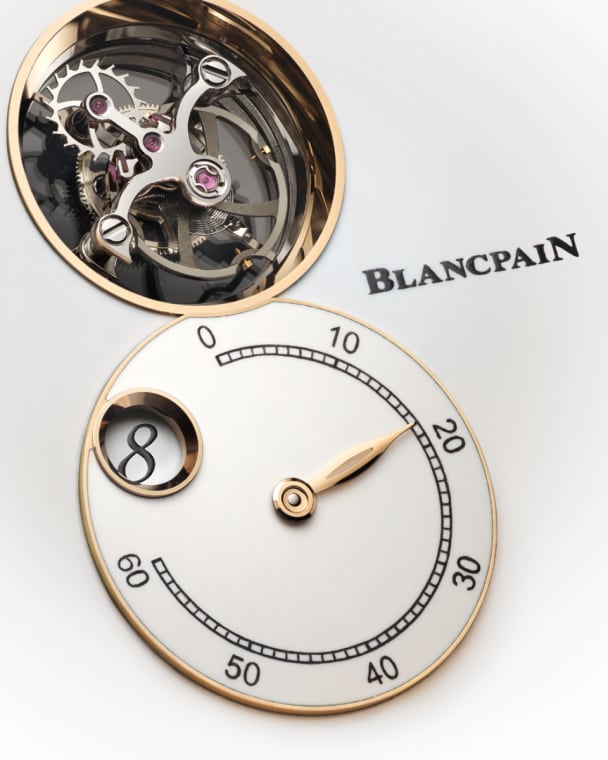
Thus, the movement designers set about conceiving a mechanism linking these two changes together. Central to the system is a snail cam rotating once per hour. The form of the cam, as the name suggests, is like a snail with a gradually increasing radius leading to a sharp drop-off from the maximum radius point to the minimum. That drop-off commands both the retrograding of the minutes and the jump of the hour. A finger rides along the outside of the cam. As it turns in a clockwise direction, the finger drives a toothed rake that engages a pinion connected to the minute hand. This movement along the increasing radius surface drives the clockwise motion of the hand. When the finger arrives at the sharp drop-off (think of it as a “cliff”), a spring forces the finger downward, retrograding the minute hand.
There is a second rake which is linked to the first through its engagement with the minute hand pinion. This second rake is central to the jumping of the hour. When the finger riding on the snail cam arrives at the drop off, retrograding the minutes, at the same time, the hour hand rake is suddenly forced upward. A finger attached to the rake then makes contact with a twelve toothed gear (you saw that one coming; one tooth for each hour), advancing it one tooth thereby changing the hour. To ensure that the hour jumps no more than one hour at a time, there is a second finger blocking a more than one-hour advance.
This design perfectly links the hour and minute indications, the jumping of the hour and the retrograding of the minute hand both being controlled by the same finger riding along the outer surface of the snail cam.
Since the system depends upon the studied shape of the cam, the issue of setting the time via the crown had to be addressed. The cam’s shape does not lend itself to counter clockwise rotation as the sharp drop-off could collide with the finger breaking the mechanism (the finger can “fall” off the cliff; it can’t climb it). To guard against this, the time-setting gear train includes a wheel which disconnects the crown from the hour/minute system if the crown is turned backwards.

Enamel is painted upon the dial’s surface by hand.
Although its appearance is pure, the dial’s construction is extraordinarily complex.
Thought was then devoted to the orientation of the minute scale. Since the minute hand does not rotate 360 degrees, instead retrograding after 270 degrees of travel, centering the 0 at the 12 o’clock position could be confusing with a quick glance at the watch. Unlike a minute hand that turns 360 degrees, 15 minutes would not be positioned horizontally to the right, 30 minutes not downward, etc. To minimize confusion, the minute scale was rotated so as to make reading by the owner more straightforward.
The same creative juices that led Blancpain to break new ground in the design of the movement were at work in the conception of the dial. Although its appearance is pure, the dial’s construction is extraordinarily complex. It begins with two disks of solid gold: in the case of the red gold version, in the same material; in the case of the limited edition platinum version, in white gold. One of the disks forms the large body of the dial. The second, smaller disk is for the zone containing the jump hour window and the minute chapter ring. For both, Blancpain turned to one of the most classic enameling techniques known as “champlevé”. In order to form a bed for layers of enamel, gold is sculpted away from the surface leaving thin surrounding rings. For the smaller of the two disks an outer ring is left as well as rings bordering the porthole for the hour display and a small ring for the minute hand axis. For the large disk an outer ring is left as well as a ring surrounding the tourbillon porthole. In Blancpain’s Métiers d’Art studio in Le Brassus, enamel artists hand paint enamel onto the surfaces bordered by the remaining rings. Respecting time-honored tradition, each layer is fired in an oven heated to 800 degrees Celsius. In order to ensure that there is no warping of the disks during firing, the back surfaces are
also painted with enamel. The combination of hand painting and multiple layers brings extraordinary depth and texture to the surface. These elaborate steps are like those followed for the creation of bespoke enamel dials with hand-painted images, one of the specialties of the Le Brassus Métiers d’Art studio.
All of the movement bridges, visible through the clear case back, have been hand guilloched with a panier spiral motif.
Once the final layer of enamel has been applied to the disks, it is fitted with larger gold rings. A large gold ring is set into the tourbillon porthole. This ring not only creates a border on the surface of the dial surrounding the tourbillon, but extends as well into the porthole all the way to the back of the movement, catching and reflecting light so as to illuminate and highlight the tourbillon. The second smaller diameter ring fits into the jump hour window, and like the tourbillon ring, extends downward into the hole.
Elaborate decoration was not confined just to the dial. All of the movement bridges, visible through the clear case back, have been hand guilloched with a panier spiral motif. Also visible through the case back is a disk, guilloched in a flame pattern upon which the power-reserve scale is placed. Locating the power-reserve indication on the back of the movement follows sound logic. Since, particularly with a manual-wind movement, the power reserve needs only to be consulted when the watch is taken off or when it is being wound, why should it be placed upon the dial where it would detract from the purity of the enamel disks? Its presence on the back of the movement fully preserves its utility and function as well as the harmony of the dial.
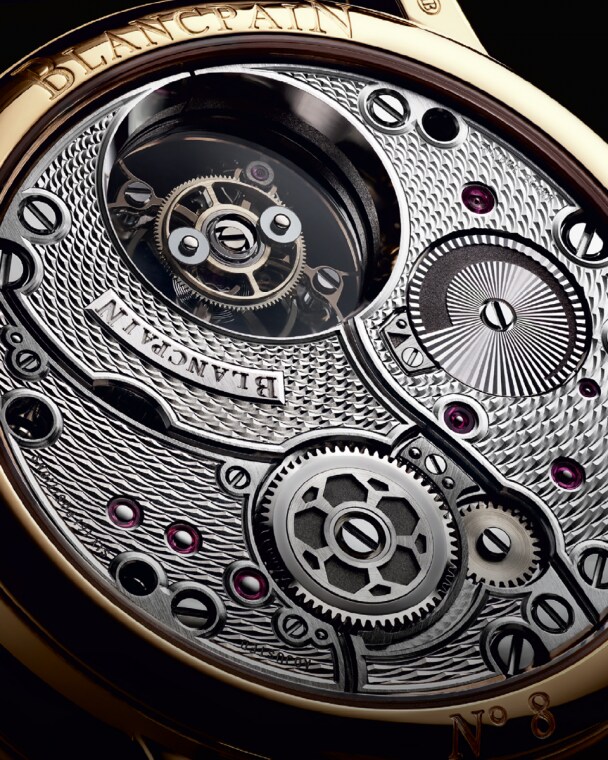
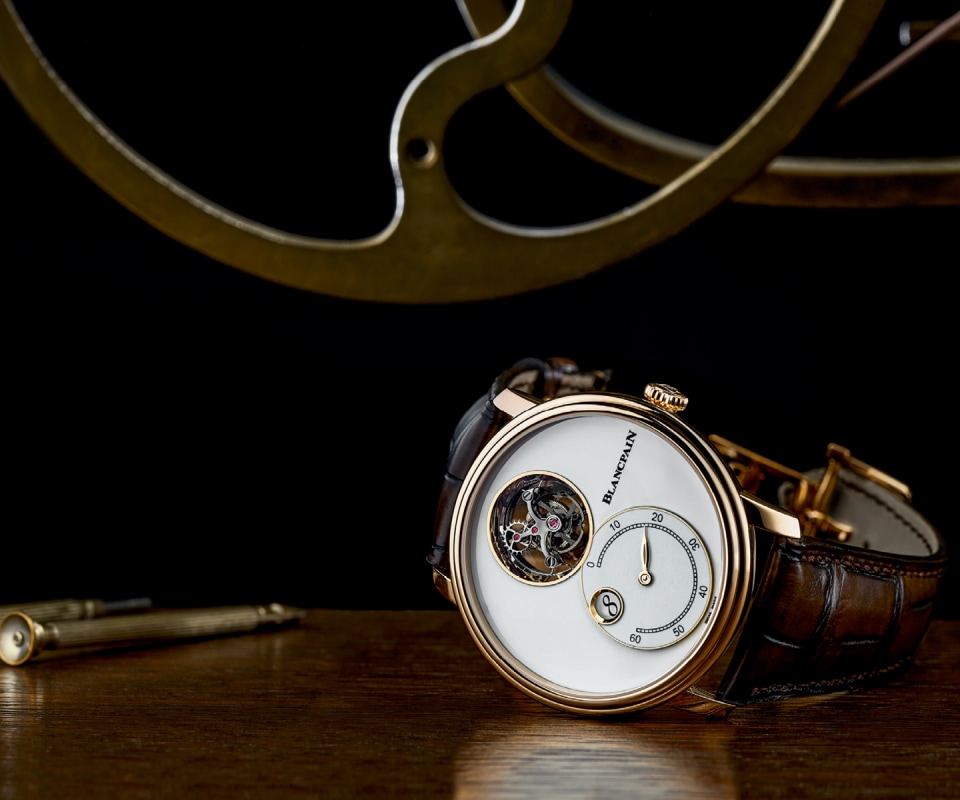
This newest tourbillon evidences BLANCPAIN’S CONTINUED DEVOTION TO THE EVOLUTION OF THE TOURBILLON.
There are two versions of the new Villeret tourbillon, red gold and an edition in platinum limited to 50 pieces. Both are housed in 42mm diameter cases.
Blancpain’s original conception of its flying tourbillon was revolutionary when it debuted, establishing many watchmaking world firsts. The debut of the Tourbillon Volant Heure Sautante Minute Rétrograde along with the 12 day tourbillon which entered the Villeret collection four years before are firm evidence of Blancpain’s continued devotion to the evolution of the tourbillon. •








